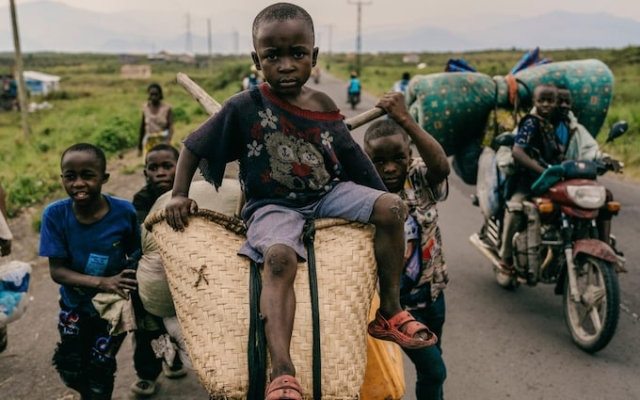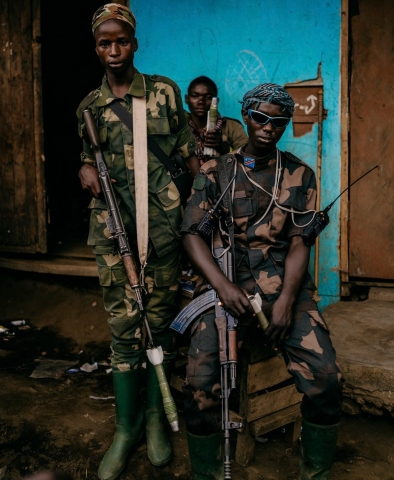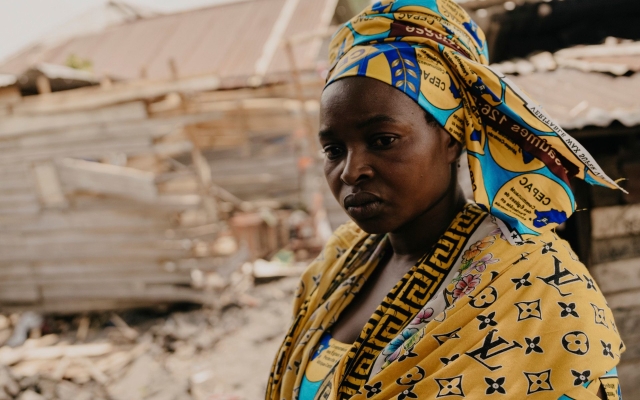 Civilians flee heavy fighting around the town of Saka Photo: Hugh Kinsella Cunningham
Civilians flee heavy fighting around the town of Saka Photo: Hugh Kinsella Cunningham
“We are so tired of running. If they want to come, they can cut us down on the spot.” Wednesday, early February, the M23 rebel military group is fast approaching, but Fatuma Mahamba is tired; she has already spent ten years on the move.
Mahamba is on the steering committee of the relocation site in North Kivu province. Thousands of families live in camps like these, white honeycombs of tents and tarpaulins that cover the green hills of eastern Congo.
“At 4 a.m. we had to escape the shelling,” she explains. “I lost five of my eight children in the chaos and didn’t find them until days later.” She left her village 18 months ago; it was the third time in her life that she had to run to safety.
Behind her, orange flashes tear the sky as the Congolese army fires rocket artillery at the rebels. The arc of the weapon is steep; the goals are close. The region has not known peace for 30 years.
After the Rwandan genocide in 1994, when Tutsi forces gained the upper hand after surviving violent killings by Hutu militias, two million people, mostly members of the Hutu ethnic group, sought refuge in the neighboring Democratic Republic of Congo. Hutu civilians and soldiers sought refuge in huge refugee camps as they reorganized their forces. For the new Tutsi-led government of Rwanda, this was an unacceptable threat.
“Rwanda first created a rebel movement, armed it, chose its leaders and sent it to the Congo in 1996,” says Michela Rong, author of Do Not Disturb, a book about human rights abuses by the Rwandan regime. The M23 movement is the latest intervention in Rwanda, the latest generation of rebel groups to devastate eastern Congo.
М23 They say they are fighting for the rights of Congolese Tutsis. Since 2022, the group has resumed its offensive. In North Kivu province alone, more than a million civilians were forced to flee their homes as a result of the fighting. Every time the front line changes, they have to move
Rwanda is widely believed to support the M23 movement, although this is denied. But the United Nations says there is evidence that Rwandan troops are fighting alongside the rebels and supplying them with weapons.
In February 2022I talked to the unfortunate Congolese soldiers. They said the M23 rebels were determined and well-equipped, armed with night vision and reconnaissance drones. The Rwandan government's position is that Congo is working with the FDLR, or Democratic Forces for the Liberation of Rwanda, one of the last militias to support the Hutu genocidal ideology.
 Congolese army units pictured after M23's attempt to capture the city of Sake Photo: Hugh Kinsella Cunningham
Congolese army units pictured after M23's attempt to capture the city of Sake Photo: Hugh Kinsella Cunningham
The presence of UN peacekeepers did not act as a deterrent for M23, and the conflict spiraled out of control, with large-scale offensives and the capture of dozens of cities.< /p>
The Congolese army, weakened by corruption and years of war, has forgiven and mobilized former enemies in hopes of slowing the rebel advance. Groups known as Mai-Mai, bands of locally recruited Congolese militias, were united and rearmed.
 May May The photo shows militia units after the recapture of the city of Burungu during the offensive against the M23 rebels. Photo: Hugh Kinsella Cunningham
May May The photo shows militia units after the recapture of the city of Burungu during the offensive against the M23 rebels. Photo: Hugh Kinsella Cunningham
I accompanied some of them when they went on the offensive last October. They go into battle believing that magical spells will protect them from bullets.
During their advance, the Mai Mai destroyed and looted villages of Congolese Tutsi — a group that M23 claims to protect — as they advanced. If peace ever comes, many citizens will have nowhere to return.
In this fog of armies and militias, civilians whose stories have survived decades are lost. Long columns of panicked families can be seen walking miles to safety, carrying their children and their belongings on their shoulders in brightly colored cloth capes. People like Moises and Rosetta, a young couple who escaped the M23 massacre in the city of Quichis and walked for days to safety in November 2022. Rosetta was heavily pregnant. More than 170 of their neighbors who decided not to leave were killed.
Ili Rugamba, a 31-year-old farmer who fled a surprise attack at 4 a.m. in the town of Malehe. He witnessed soldiers changing into uniform to flee with the population, only to be stopped by military police and forced to return to the front.
There are few places left to hide. Last month I traveled to the city of Sake to see the aftermath of an M23 mortar attack. Two small lifeless bodies were hidden under the sheet. Blood stains soaked into the fabric. Children seven and eight years old died as a result of a shell explosion. Their mother Mokili was also killed.
 Family members are mourning the death of Mokili Mianjo and her two children. Photo: Hugh Kinsella Cunningham
Family members are mourning the death of Mokili Mianjo and her two children. Photo: Hugh Kinsella Cunningham
The Congo is a story of loss and abandonment, where every battle leaves grudges for the next generation. For Justine Masika Bihamba, one of Congo's leading women's rights activists, this has gone on for too long. “Soldiers and militias commit atrocities against their brothers in the name of peace,” she says. “The Congolese people must realize that we are the ones who must be part of the change and find the solution.”
But working for change is difficult. Eastern Congo is under military rule, civilian voices for peace have been ignored and silenced, and foreign diplomatic pressure on Rwanda to end its involvement in the M23 movement has so far been unsuccessful.
The conflict threatens to turn the entire region upside down. Troops from Tanzania and South Africa were recently deployed to fight alongside the Congolese military. North Kivu is once again a bloody canvas on which power and discontent are expressed.
This story was supported by the Pulitzer Center























































Свежие комментарии